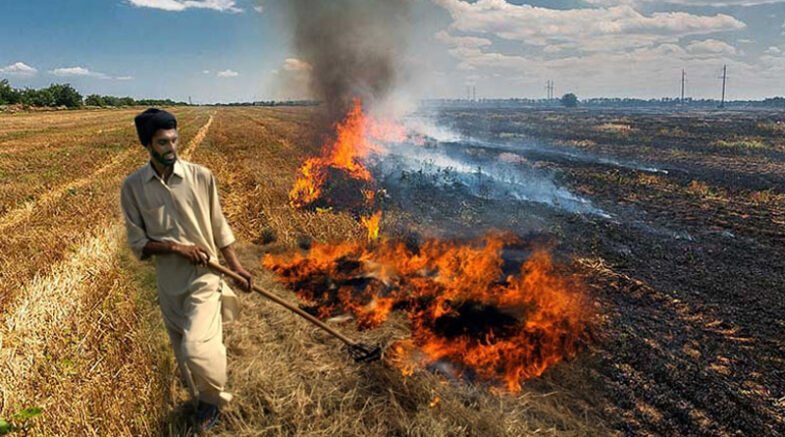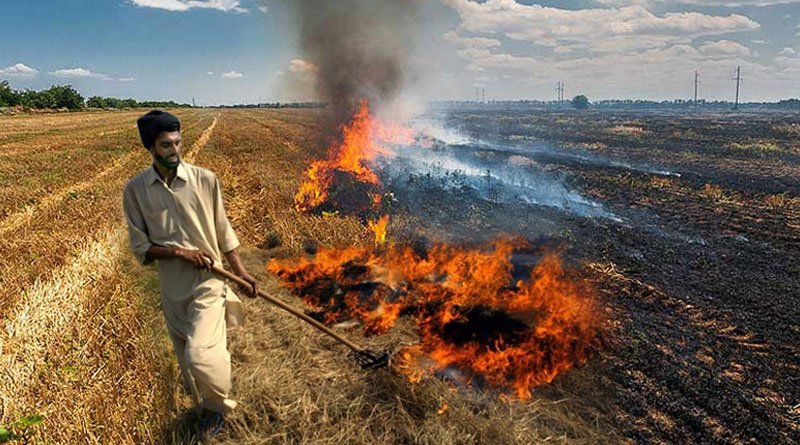The burning of this rice stubble kills the beneficial microbes, which further slows down the process of decomposing organic matter.

The economy of most South Asian countries is based on agriculture and rice is the main crop, contributing the major share. Rice feeds about one-third of the world’s population as a major cereal crop and staple food. It is a rich source of starch comprising amylose and amylopectin, which are primary sources of energy. rice stubble
Pakistan is the 10th largest exporter of rice, and its aroma is admired all over the world. In Pakistan, rice represents the Kharif crop, which is sown in July and harvested in November. After the harvest of rice, the paddy is processed to yield the rice, while the straw remains in the fields as a huge bulk of stubble.
Contrary to other crops like wheat, maize, etc., the rice straw is composed of high contents of cellulose and lignin which are resistive to decomposition. So, these rice stubble are difficult to use as organic matter in agricultural soils.
Besides that, these lignin contents cause digestibility problems in cattle, and cattle do not like them as feed. The farmers, on the other hand, want to get rid of these rice stubble as early as possible to avoid delays in the following crops in their rotation.
Farmers prefer to burn the crop straw in an open field since managing crop straw is expensive, time-consuming, and requires a lot of labor. The burning of these rice stubble generates atmospheric aerosols and gaseous pollutants (i.e., CO2, CH4, SOX, and particulate matter). These gaseous pollutants envelop the atmosphere and capture and retain UV radiation, which has deteriorating effects on the environment.
These pollutants are also the major source of climatic changes, followed by disasters in the form of irregular rainfalls, floods, climate shifts, extreme weather, etc. In winter, when the temperature is very low and the humidity is high, these greenhouse pollutants adhere to water droplets and generate smog in the atmosphere.
Smog encompasses a broad category of secondary pollutants due to the presence of volatile carbon compounds, water droplets, NOXs, and SOXs in the environment. Smog has become a major environmental concern because it not only reduces the visibility of the atmosphere, but also causes multiple diseases in animals and humans.
Common diseases in human beings due to smog include asthma, emphysema, bronchitis, eye irritation, skin conditions, and other illnesses.
Environmental scientists believe that the burning of crop residues, specifically rice, is a single major cause of smog in the atmosphere. The burning of crop residues also affects the physio-chemical properties of soils. The fertility of soils is compromised during the process of burning because carbon and nitrogen materials are lost from the soils in the form of gasses.
High temperatures of the burning process directly affect the ecology of flora and fauna in the soils. The burning of the rice stubble kills the beneficial microbes, which further slows down the process of decomposition of organic matter. Besides that, some nitrogen-fixing bacteria will also burn in this fire.
In Pakistan, the market value of rice is increasing day by day, which is bringing more agricultural area under rice cultivation. This positive trend toward rice cultivation necessitates addressing the environmental issues associated with the mismanagement of rice stubble.
As environmental scientists, we can devise different management options in collaboration with agriculture scientists and extension staff.
- Making the bails and co-digesting rice straw with other straw and waste products like sawdust increased biogas production, which can be used as fuel as a renewable energy, and as a supplement for gas shortage in winter.
- We might use rice straw for mulching operations in tunnel farming as it protects the soil by covering it with various materials, which has been shown to increase the soil’s health.
- The Happy Seeder (zero tillage) is a good option for rice farmers since it guarantees timely seeding of the wheat crop. Using a Happy Seeder, farmers may instantly plant seeds after harvesting the paddy field using a combined harvester. However, due to its expensive price and lack of expertise, this equipment isn’t utilized very frequently.
- Straw burning can be replaced by the efficient breakdown of rice residue, including cellulose and lignin. By retrieving more nutrients and reintroducing them to the soil, the breakdown of rice straw restores the soil’s fertility. There, the straw breaks down, primarily aerobically, and at the beginning of the growing season, the compost may be added to the soil as fertilizer.
- Thermochemical process with pyrolysis is used to make the biochar from rice straw, which can also be beneficial for contaminated soils as it increases the soil carbon and sequestration levels and improves soil health.
- Another management method that increases soil formation and is utilized as fertilizer is composting. Typically, this method is used to handle garbage generated from off-field. Vermi-composting and windrow composting are used.
- It is crucial to inform farmers about the financial and environmental benefits of using alternative approaches, and to promote the use of equipment like zero tillage, happy seeders, mulching, and composting of a rice crop to manage crop residue. Additionally, it is important to motivate farmers to employ in-situ management strategies and discourage the outdoor or open-field burning of agricultural wastes.
- Legislation and legal implementation should be promoted to help farmers avoid the consequences, and also incentives should be given to the farmers.
In order to stop this detrimental practice of rice stubble burning, the government must take a more active role in executing such policies or activities planned or recommended by different government or non-government organizations.
Crop leftovers should be recognized as recycled fertilizers and encouraged by the government for use as fertilizers or amendments. Crop rotation systems that grow paddy rice during the wet season should be acknowledged by farmers.
